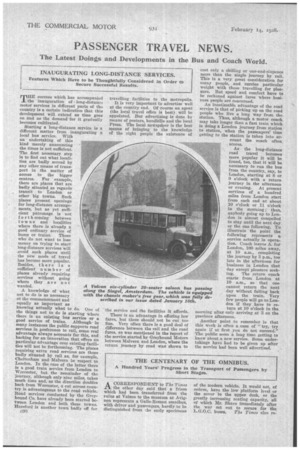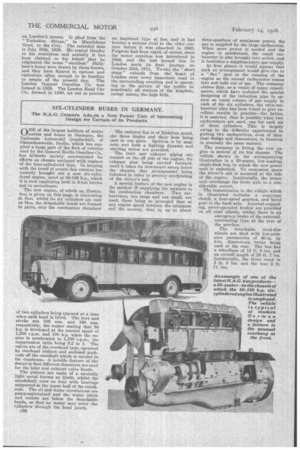THE CENTENARY OF THE OMNIBUS.
Page 58

Page 59

Page 60

If you've noticed an error in this article please click here to report it so we can fix it.
A Hundred Years' Progress in the Transport of Passengers by Short Stages.
A CORRESPONDENT to The Times 11 the other day Said that a frieze which had been transferred from the ruins at Vaison to the museum at Avignon represents a Gallo-Roman omnibus, with driver and passengers, hardly to be
distinguished from early specimens of the modern vehicle. It would not, of course, have the low platform level or the cover to the upper deck, or the greatly increasing seating capacity, all of which Mr. Shave immediately after the war set out to secure for the
L.G.O.C. buses. The Times also re
minds us that, following upon the enterprise of M, Baudry, the first omnibus appeared on the boulevards in Paris on January 30th, 1828. Other French towns had their public passenger services, but it wak M."
Baudry who chose for the innovation in•Paris the word omnibus, intending to
convey the fact that the vehicle was open to all, whatever their class or rank. The fare, according to our contemporary, was 25 centimes, which at that period must have been a fairly high figure, but it was not considered ex orbitant in the circumstances, the service being unique.
The buses of M. Baudry accommodated 14 passengers each, and, according to an old print, they were shaped to represent three carriage bodies built in series. According to the inscription they would stop when a signal was made to the driver or conductor. The route, which was followed was along the Boulevard de Gand (now the Boulevard des Italiens), from the Bastille to the Madeleine, and at first the public needed some encouragement before it would patronize the new vehicle. Then one day the Duchesse de Berry, one of the reigning beauties, gave the service a fillip by taking a ride in one of the
• buses as far as the Bastille, and that seems to have been as effective in setting a fashion as to-day a cinema star will by creating a new style of coiffure. Competition set in and M. Baudry found himself in such financial difficulties a year later that he committed suicide, but the bus company was parried on by others and gradually • developed. During the second Bmpire the ten companies catering for public passenger transport were amalgamated under the title of the Compagnie GenArale cres Omnibus, obtaining a monopoly from the Government. and the transition from horses to the motor followed in due course.
The heyday of the road was in the pre-railway period, for there was no alternative to the saddle horse and the stage roach. With the growth of industry and the concentration of the merchant classes in towns, the " short stage" became popular, plying into and out of town, and it is recorded by C. G. Harper that about 1825 no fewer than 850 of these were licensed to travel to places not more than 20 miles from London, coming in to the inns in the Borough, a* Whitechapel, Holborn and elsewhere.
It was George Shillibeer who, in 1829, the year when Baudry died a disappointed man, put the first omnibus on London's streets. It plied from the " Yorkshire Stingo," in Marylebone Road, to the City. The recorded date is July 20th, 1829. He copied Baudry in his enterprise and actually it has been claimed on his behalf that he originated the name "omnibus." Shillibeer's buses were drawn by three horses, and they have figured in cartoon and caricature often enough to be familiar to people of the present day. The London General Omnibus Co. was formed in 1855. The London Road Car Co., formed in 1880, set out to provide
an improved type of bus, and it had become a serious rival to the older concern before it was absorbed in 1908. Progreso had been rapid, of course, since the motor omnibus was introduced in 1904, and the last horsed bus in London made its final journey on October 25th, 1911. To-day the short • stage" extends from the heart ef London over every important road in the surrounding counties, and is operating in the service of the public in practicaily all corners of the kingdom, except among the high hills.












































































































